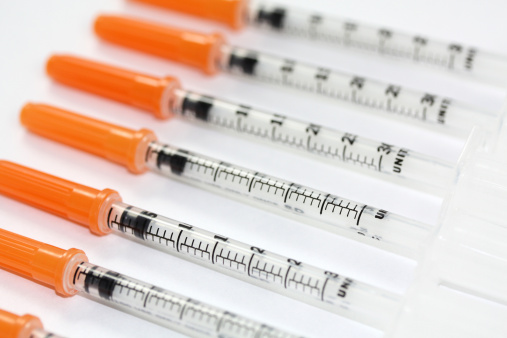Classifying Different Types of Insulin

Diabetes in the United States has been exploding, increasing from 26 million in 2010 to 29 million in 2012 alone. More than 200,000 people under the age of 20 have been diagnosed with diabetes.
Here is a quick overview and refresher of the different types of insulin now in use to treat diabetes.
There are seven different types of insulin on the market today — lispro (brand name Humalog), aspart (brand name NovoLog), glulisine (Apidra), regular (Humulin R), NPH (Humulin N), glargine (Lantus), detemir (Levemir).
Lispro, aspart, and glargine are analog insulin, genetically modified to work more quickly or slowly.
Three types of insulin – NPH, glargine, detemir – are background or basal insulin, acting continuously for up to 24 hours. These types are absorbed slowly.
- NPH – This insulin begins to take effect about two hours after taking it. It peaks at about six to eight hours, and lasts from 10 to 16 hours.
- Glargine – This also takes effect after about two hours and lasts from 20 to 24 hours.
- Detemir – Begins to act about two hours after taking and lasts from 14 to 24 hours.
The other four types are known as mealtime insulin because they are fast-acting in order to counteract the sugar a person ingests at mealtime. They also wear off quickly.
- Aspart – This insulin type begins to work in 5 to 15 minutes, peaks at 90 minutes, and lasts 3 hours.
- Lispro – Also starts to take effect in 5 to 15 minutes, peaks at 90 minutes, and stops at 3 hours.
- Glulisine – This too begins working in 5 to 15 minutes, peaks at 90, and stops after 3 hours.
- Regular – This insulin begins working in 30 to 60 minutes, peaks in about 2 hours, and lasts 4 to 6 hours.
There is also a combination-type insulin, which mix the longer-lasting types with the fast-acting types. Manufacturers claim that this type of insulin delivers the best of both worlds, but the likely effect is that it takes effect later but has a stronger peak.
One type of this combination insulin is known as 70-30, which is70 percent NPH insulin and 30 percent regular insulin.
If you are a pharmacist looking for a job, Rx relief should be the first place you go. We have a track record of success in placing pharmacists with the best of staffing awards to prove it. Give Rx relief a call today.



